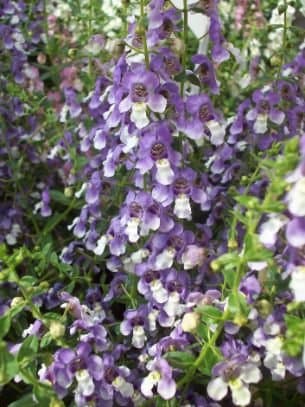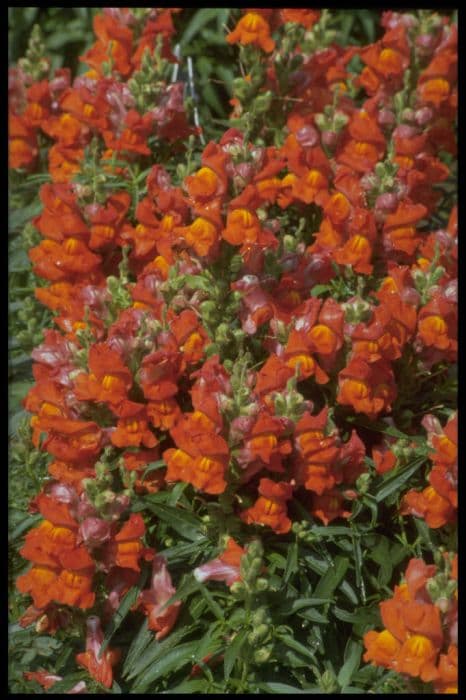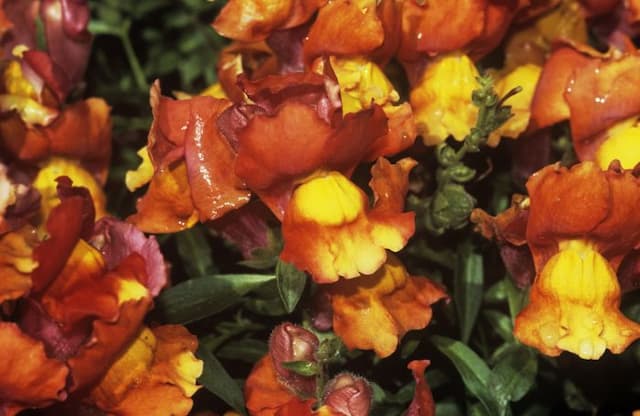Beardtongue Penstemon 'Strawberries and Cream' (Ice Cream Series)

ABOUT
Penstemon 'Strawberries and Cream', part of the Ice Cream Series, is a delightful perennial plant known for its ornamental appeal. The plant boasts an eye-catching display of tubular flowers, closely resembling the appearance of snapdragons. The blossoms are a harmonious blend of soft pink and creamy white, creating an alluring effect reminiscent of the dessert its name suggests. The flowers cluster along the stem, lushly arranged to give an impression of abundance and soft texture. Each bloom showcases a gradient of hues, transitioning from a deeper, strawberry pink at the throat, gradually lightening to a whipped cream-white at the edges. The foliage of 'Strawberries and Cream' provides a pleasing contrast with its deep green color and lance-shaped leaves, which are attractively arranged along the stems, enhancing the overall fullness of the plant. This Penstemon variety exudes a charming cottage garden aesthetic, making it a captivating addition to borders, beds, and outdoor living spaces.
About this plant
 Names
NamesFamily
Plantaginaceae
Synonyms
Beardtongue, Penstemon
Common names
Penstemon 'Strawberries and Cream'
 Toxicity
ToxicityTo humans
Penstemon 'Strawberries and Cream', commonly referred to as Penstemon, is not known to be toxic to humans. However, it is always recommended to exercise caution and avoid ingesting any part of ornamental plants as they are not intended for consumption, and individual sensitivities or allergic reactions could occur.
To pets
Penstemon, the common name for Penstemon 'Strawberries and Cream', is not listed as toxic to pets by the ASPCA and other prominent pet safety organizations. While it is considered non-toxic, ingestion of plant material could potentially lead to gastrointestinal upset in some pets due to the novelty of the plant matter. If any unusual symptoms follow ingestion, it is advisable to consult a veterinarian.
 Characteristics
CharacteristicsLife cycle
Perennials
Foliage type
Semi-deciduous
Color of leaves
Green
Flower color
Pink
Height
2 feet 3 inches (70 cm)
Spread
2 feet (60 cm)
Plant type
Herb
Hardiness zones
6
Native area
North America
Benefits
 General Benefits
General Benefits- Attracts Pollinators: Penstemon 'Strawberries and Cream' is known for attracting bees and butterflies, aiding in the pollination of your garden.
- Visual Appeal: With its striking bi-colored flowers, this cultivar adds aesthetic beauty to any landscaping scheme.
- Drought Tolerance: Once established, it is relatively drought tolerant, making it ideal for water-wise gardens.
- Low Maintenance: This Penstemon variety does not require constant care or maintenance, making it suitable for gardeners of all levels.
- Hardy Perennial: As a perennial, it will return year after year, providing long-term value in the garden.
- Habitat Enhancement: Its presence can help provide a suitable habitat for beneficial fauna.
- Versatile Planting Options: Can be used in a variety of garden styles including borders, rockeries, and as part of a perennial bed.
- Long Blooming Season: It has a relatively long flowering period, which ensures color in the garden for an extended time.
 Medical Properties
Medical PropertiesThis plant is not used for medical purposes.
 Air-purifying Qualities
Air-purifying QualitiesThis plant is not specifically known for air purifying qualities.
 Other Uses
Other Uses- Photography Prop: Penstemon can be used as an elegant backdrop or focus for nature photography, with their unique 'Strawberries and Cream' coloration adding subtle charm to the photos.
- Educational Tool: Gardeners and botany teachers can use the distinct features of Penstemon to teach lessons in plant identification, pollination, and hybridization.
- Insect Habitat: By planting Penstemon in your garden, you can provide a habitat and food source for beneficial insects, such as certain species of bees and butterflies.
- Culinary Garnish: Although not a traditional edible, Penstemon flowers can be used as an ornamental garnish for salads and desserts, provided they haven't been treated with pesticides.
- Therapeutic Gardening: The process of planting and nurturing Penstemon can serve as a form of relaxation and therapy for individuals needing stress relief or physical rehabilitation.
- Artistic Inspiration: Artists can draw inspiration from the color patterns and structure of Penstemon for use in various forms of artwork, including painting and textile designs.
- Dye Source: The pigments in Penstemon flowers could potentially be used to create natural dyes for fabrics or crafts, although this application is not well-documented.
- Event Decor: Penstemon's striking appearance makes them suitable for use in event decorations, such as weddings or garden parties, particularly for table centerpieces.
- Children's Projects: The fast growth and easy care of Penstemon make them ideal for children’s gardening projects, promoting an interest in botany from an early age.
- Scent Garden Element: While Penstemon is not known for a strong fragrance, they can contribute to the visual aspect of a scent garden, supporting more fragrant surrounding plants.
Interesting Facts
 Feng Shui
Feng ShuiThe Penstemon is not used in Feng Shui practice.
 Zodiac Sign Compitability
Zodiac Sign CompitabilityThe Penstemon is not used in astrology practice.
 Plant Symbolism
Plant Symbolism- Charm and Grace - The name 'Strawberries and Cream' suggests a delicate balance and sweetness which may symbolize the presence of charm and grace in one's life.
- Striking Beauty - As part of the Ice Cream Series, the vivid colors and patterns of Penstemon reflect an eye-catching and stunning beauty that stands out in any garden.
- Boldness and Diversity - Penstemon varieties are known for their wide range of colors and resilient nature, which can represent boldness and the ability to thrive in diverse situations.
- Communication and Expression - With their tubular flowers, often associated with bell shapes, they can symbolize the need for clear communication and expression of thoughts and feelings.
- Love and Appreciation - The tender name 'Strawberries and Cream' might also suggest notions of love, sweetness, and appreciation for the simpler, finer things in life.
 Water
WaterBeardtongue should be watered deeply once a week, allowing the soil to dry out between waterings. During hot or dry spells, check the soil more frequently and water as needed to prevent stress. Provide about 1 gallon of water to the base of the plant, avoiding overhead watering to reduce the risk of fungal diseases. In the winter or during cooler weather, reduce watering to prevent waterlogging as Beardtongue is sensitive to overwatering, particularly when temperatures are cooler.
 Light
LightBeardtongue thrives in full sun conditions, receiving at least 6 to 8 hours of direct sunlight each day. It's best planted in a location where it can enjoy unfiltered sunlight throughout the day for optimal growth and flowering. However, in regions with very intense sun, some light afternoon shade can be beneficial to prevent scorching.
 Temperature
TemperatureBeardtongue is hardy and can withstand temperatures as low as 20 degrees Fahrenheit, but prefers a range between 60 and 70 degrees Fahrenheit for optimal growth. Ensure the plant is protected from extreme cold by providing mulch or bringing it indoors if potted. It can survive up to around 90 degrees Fahrenheit but may require additional water in higher temperatures.
 Pruning
PruningPrune Beardtongue by deadheading spent flowers to encourage additional blooming and to keep the plant looking tidy. In late fall or early spring, cut back the foliage to a few inches above ground level to promote healthy new growth. Pruning is generally done annually or as needed to remove dead or damaged stems.
 Cleaning
CleaningAs needed
 Soil
SoilPenstemon 'Strawberries and Cream' prefers well-draining soil with a moderate amount of organic matter. A mix of two parts garden soil, one part sand, and one part compost would suit it well. The ideal soil pH for Beardtongue, the common name for Penstemons, is slightly acidic to neutral, ranging from 6.0 to 7.0.
 Repotting
RepottingBeardtongues should be repotted every 2-3 years to refresh the soil and accommodate root growth. However, they do not generally like being disturbed, so repot only when necessary and handle roots with care during the process.
 Humidity & Misting
Humidity & MistingBeardtongue plants prefer moderate humidity levels but are quite adaptable and can tolerate the varying humidity conditions typically found in outdoor environments. Therefore, there is no specific humidity requirement for these hardy perennials.
 Suitable locations
Suitable locationsIndoor
Ensure bright light, well-draining soil, and infrequent watering.
Outdoor
Full sun, well-drained soil, water regularly, protect from harsh winds.
Hardiness zone
6-9 USDA
 Life cycle
Life cyclePenstemon 'Strawberries and Cream', commonly known as Beardtongue, generally begins its life cycle with seed germination occurring in late winter to early spring, depending on the climate. Following germination, the seedlings grow and establish a root system, developing into young plants with characteristic lance-shaped leaves. As the plants mature, they enter the vegetative growth stage where they gain height and mass during late spring to early summer. By mid to late summer, the plant produces tall flowering stalks adorned with bell-shaped flowers in a striking pattern of pinks and whites resembling strawberries and cream. After the flowering period, the plant sets seed; these seeds either drop to the ground to self-sow or can be collected for propagation. As the cooler weather of autumn arrives, the plant begins to die back, retreating into dormancy during the winter months, though it is a perennial and will re-emerge from its root system the following spring.
 Propogation
PropogationPropogation time
Spring-Early Summer
Penstemon 'Strawberries and Cream', commonly known as Beardtongue, is propagated most effectively by cuttings, although it can also be grown from seeds. The ideal time for taking cuttings is late spring to early summer when the plant is actively growing. You begin by selecting healthy, non-flowering stems and cutting them to a length of about 4 to 6 inches (10 to 15 centimeters). Remove the leaves from the lower half of the cutting, and then dip the cut end into a rooting hormone. This stimulates root growth and helps ensure a successful propagation process. Place the prepared cutting into a pot with well-draining soil, then water it thoroughly. Keep the soil consistently moist and place the pot in a warm area with indirect sunlight. Roots typically develop within a few weeks, after which the new Penstemon can be transplanted into the garden.









